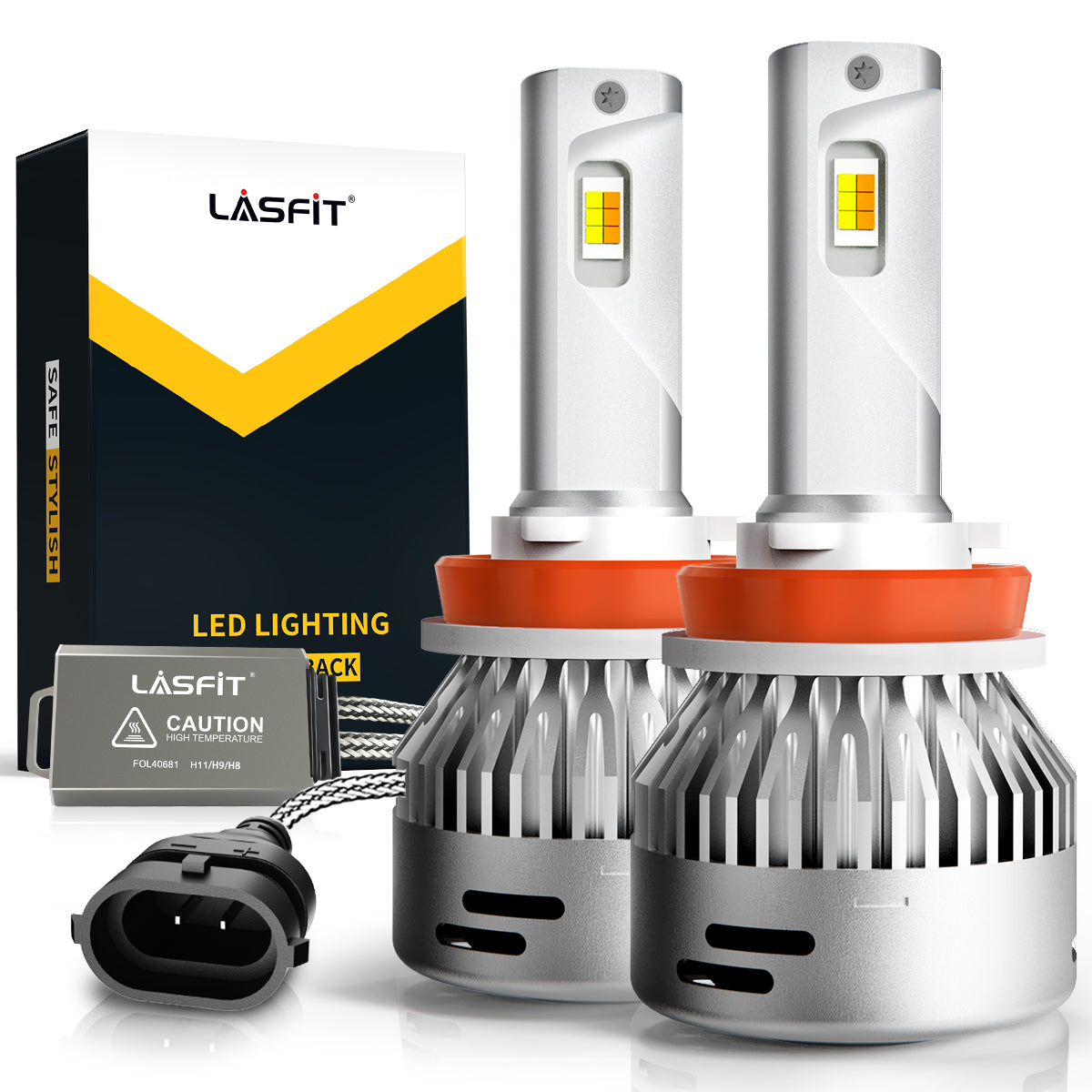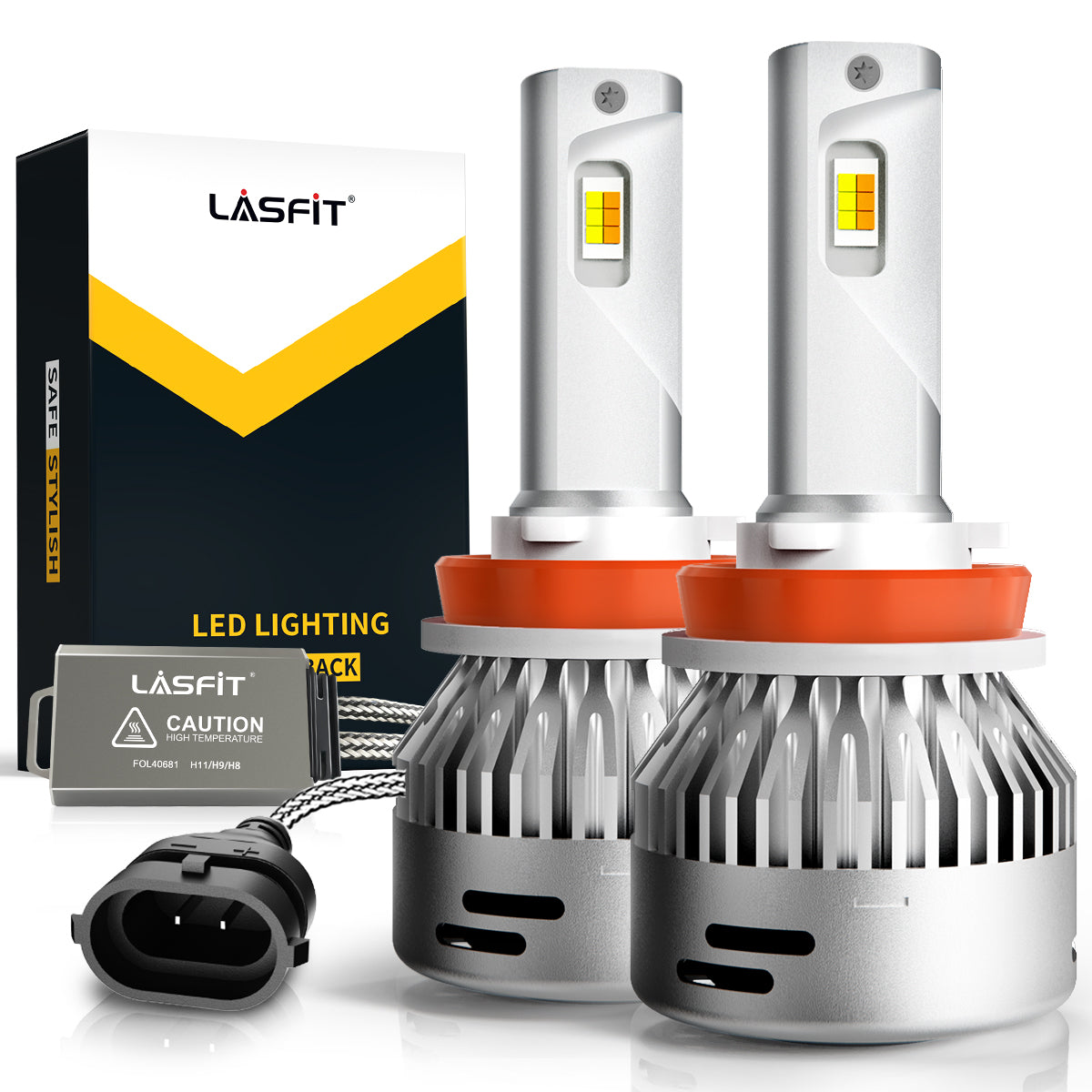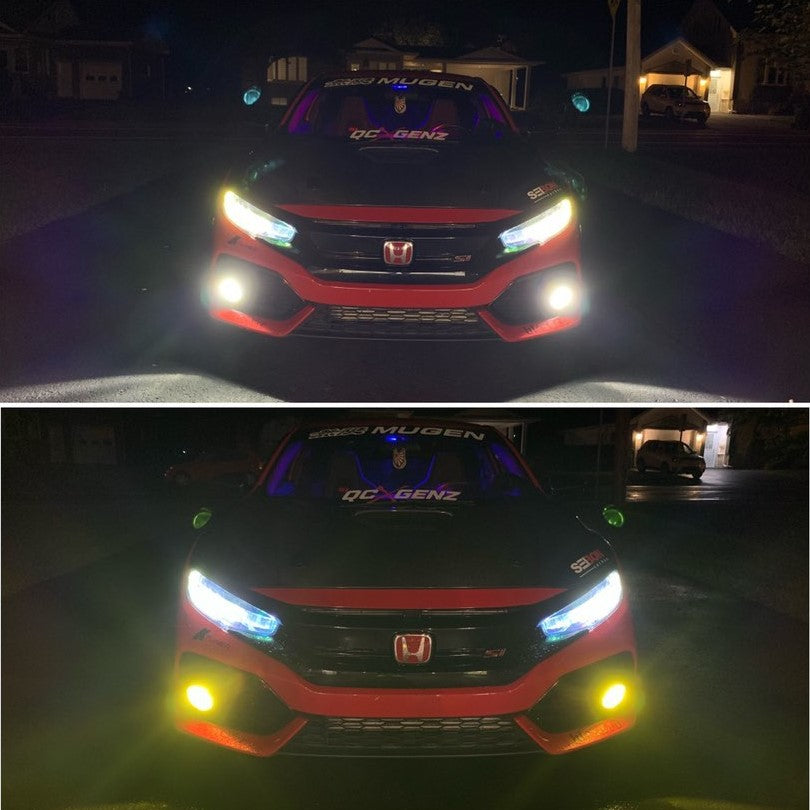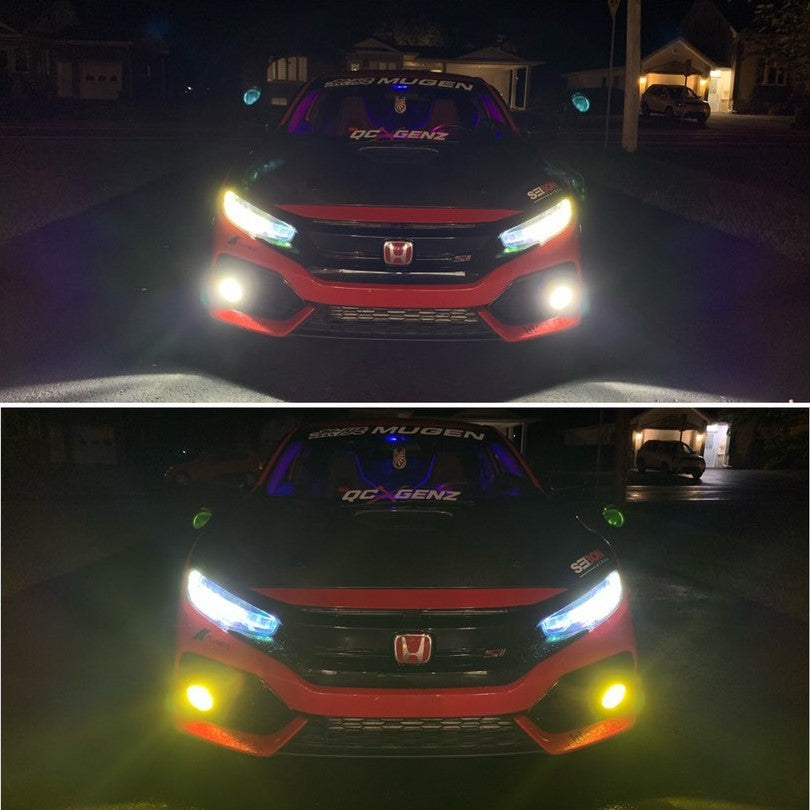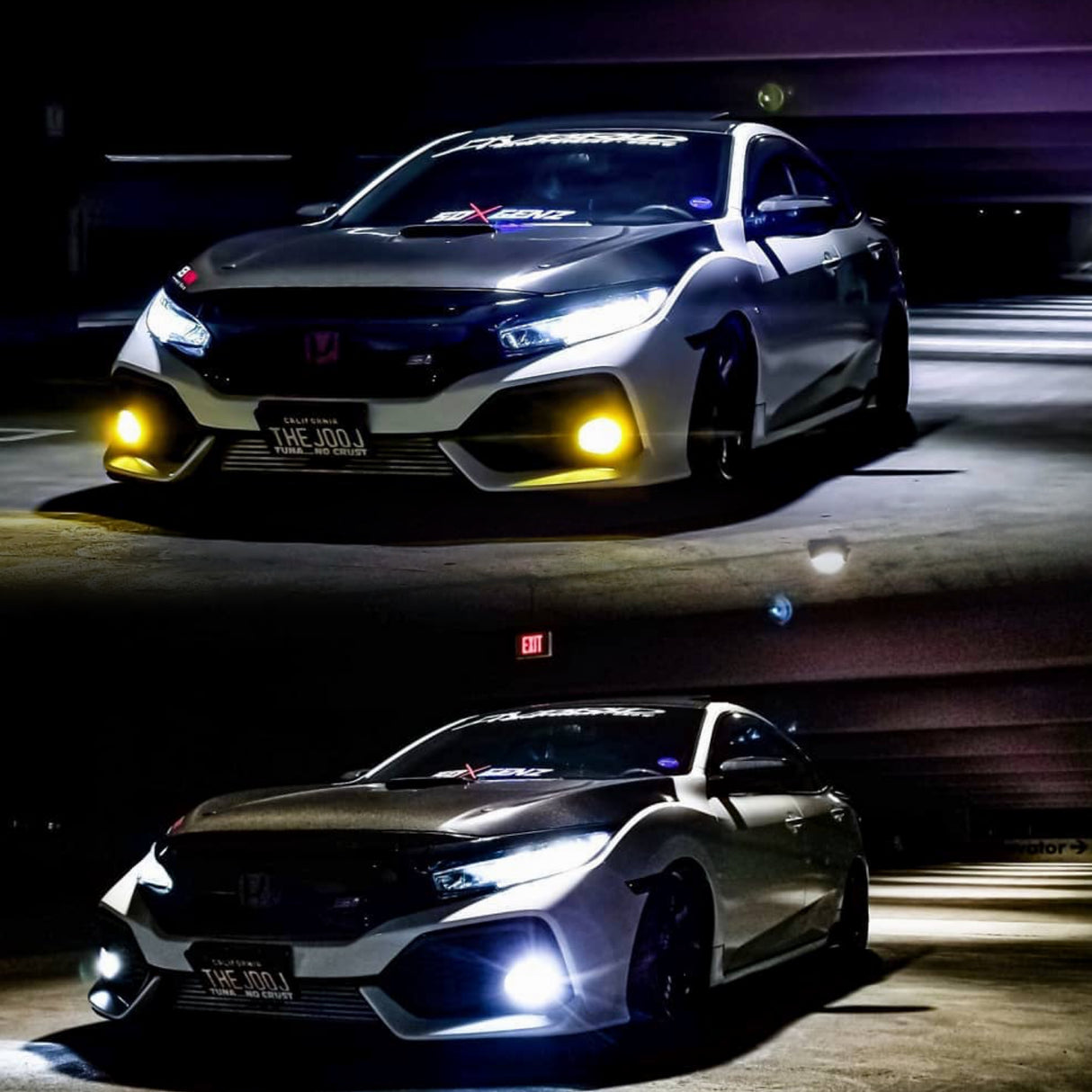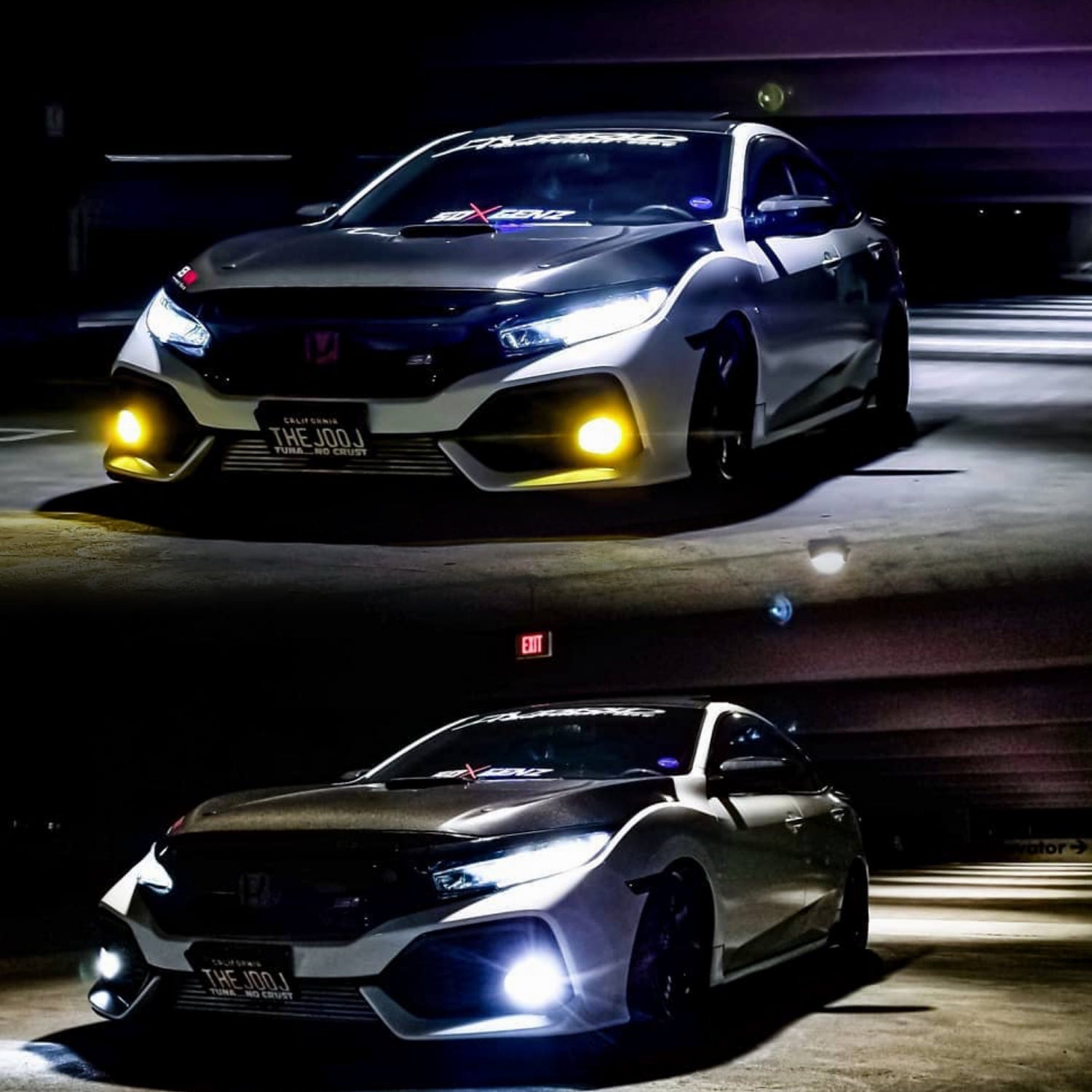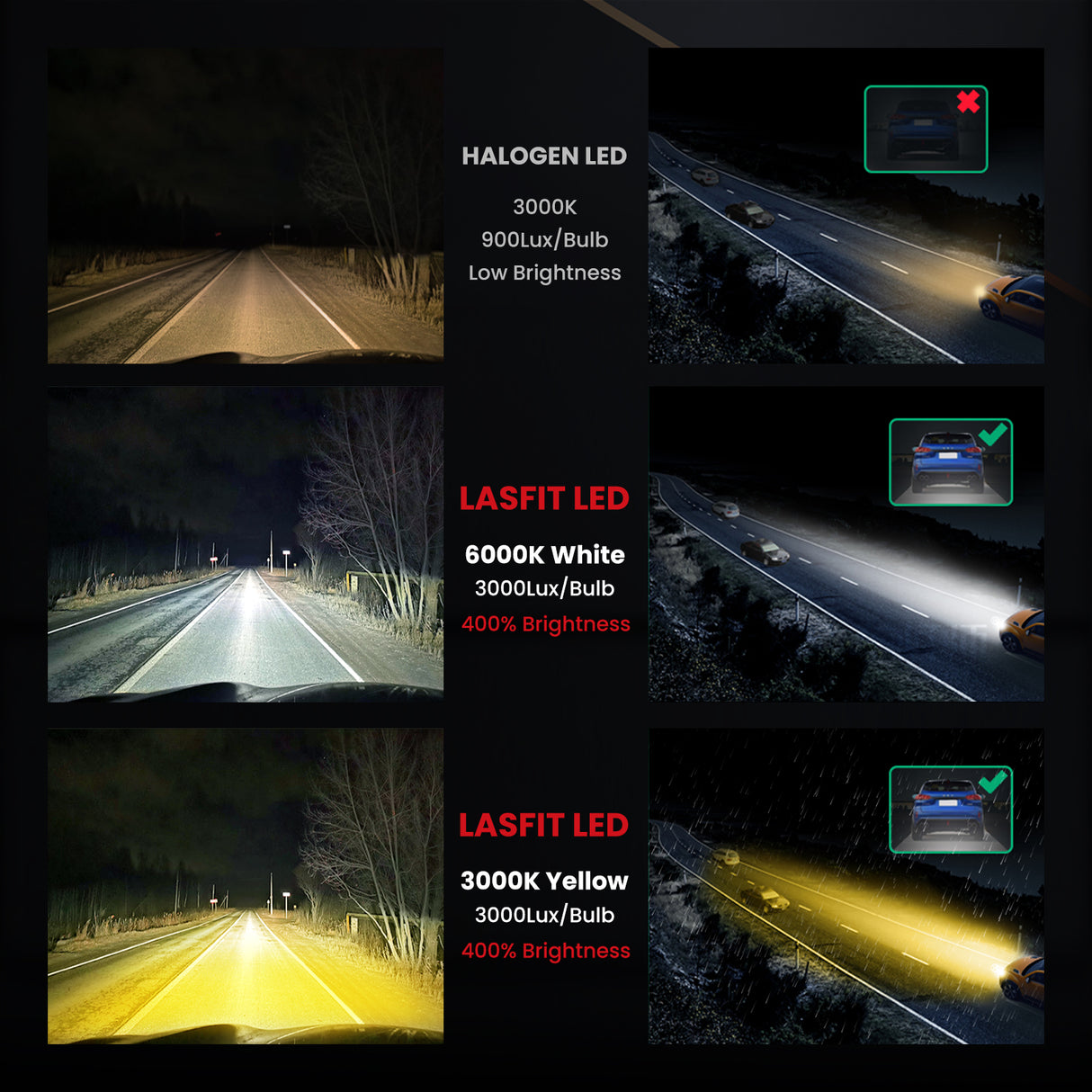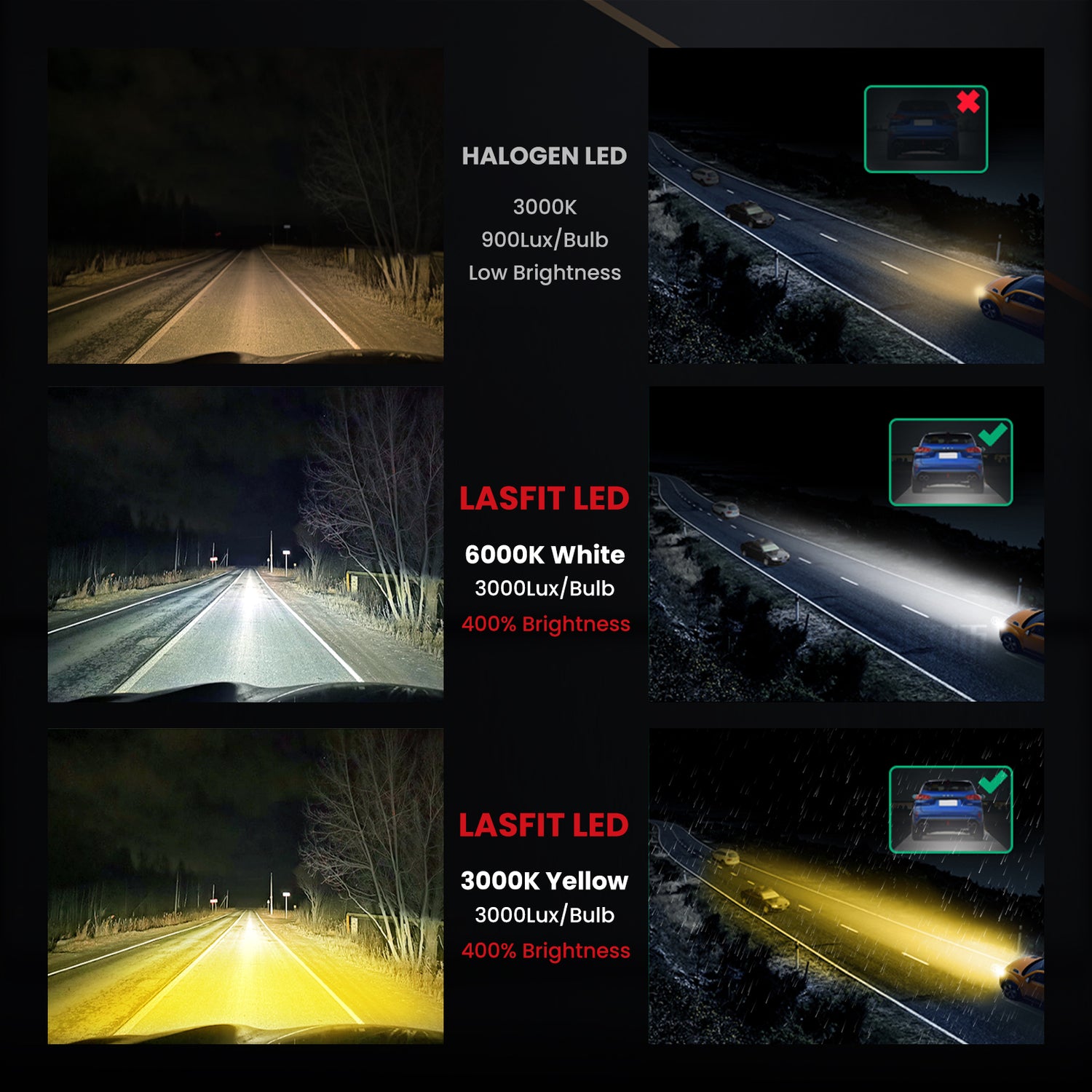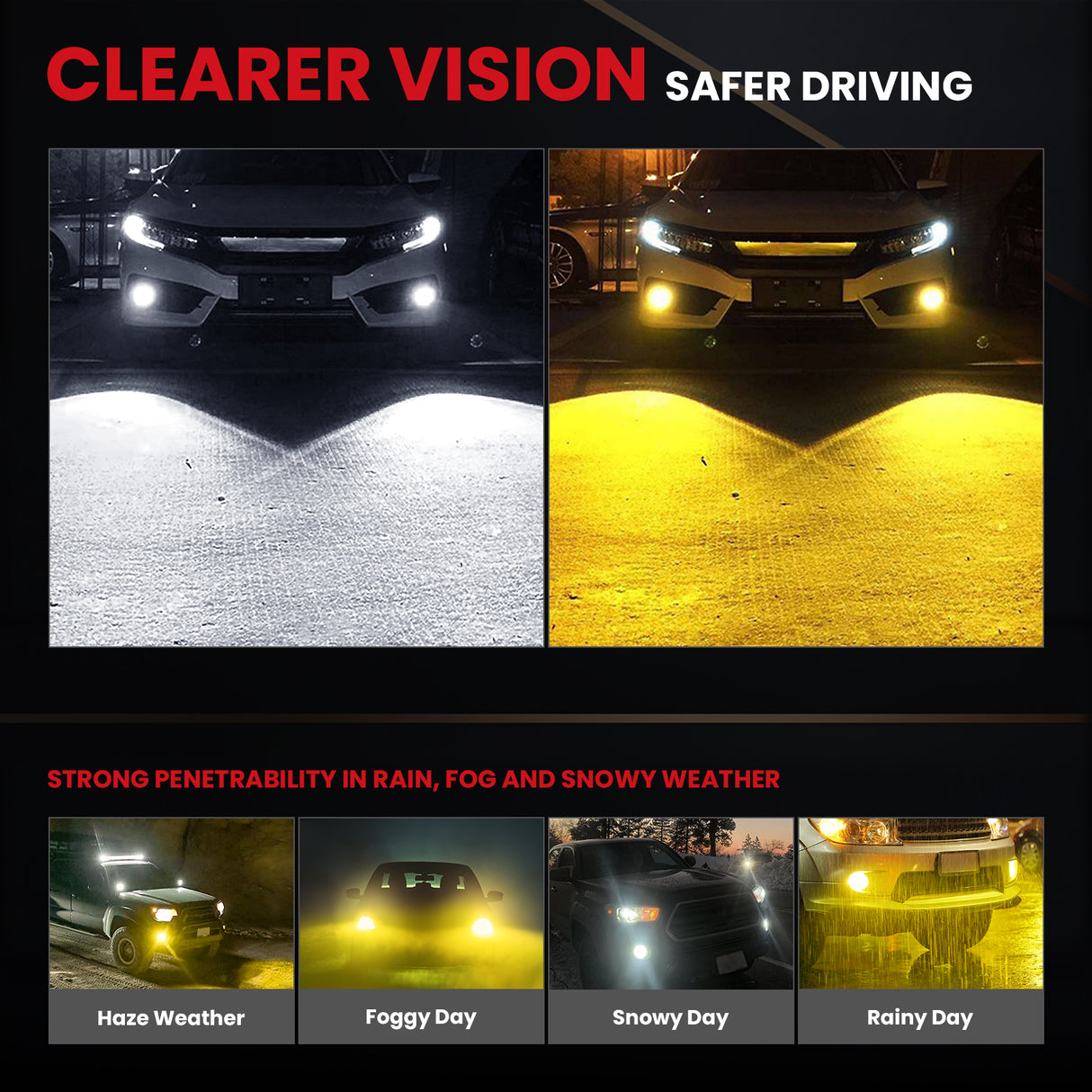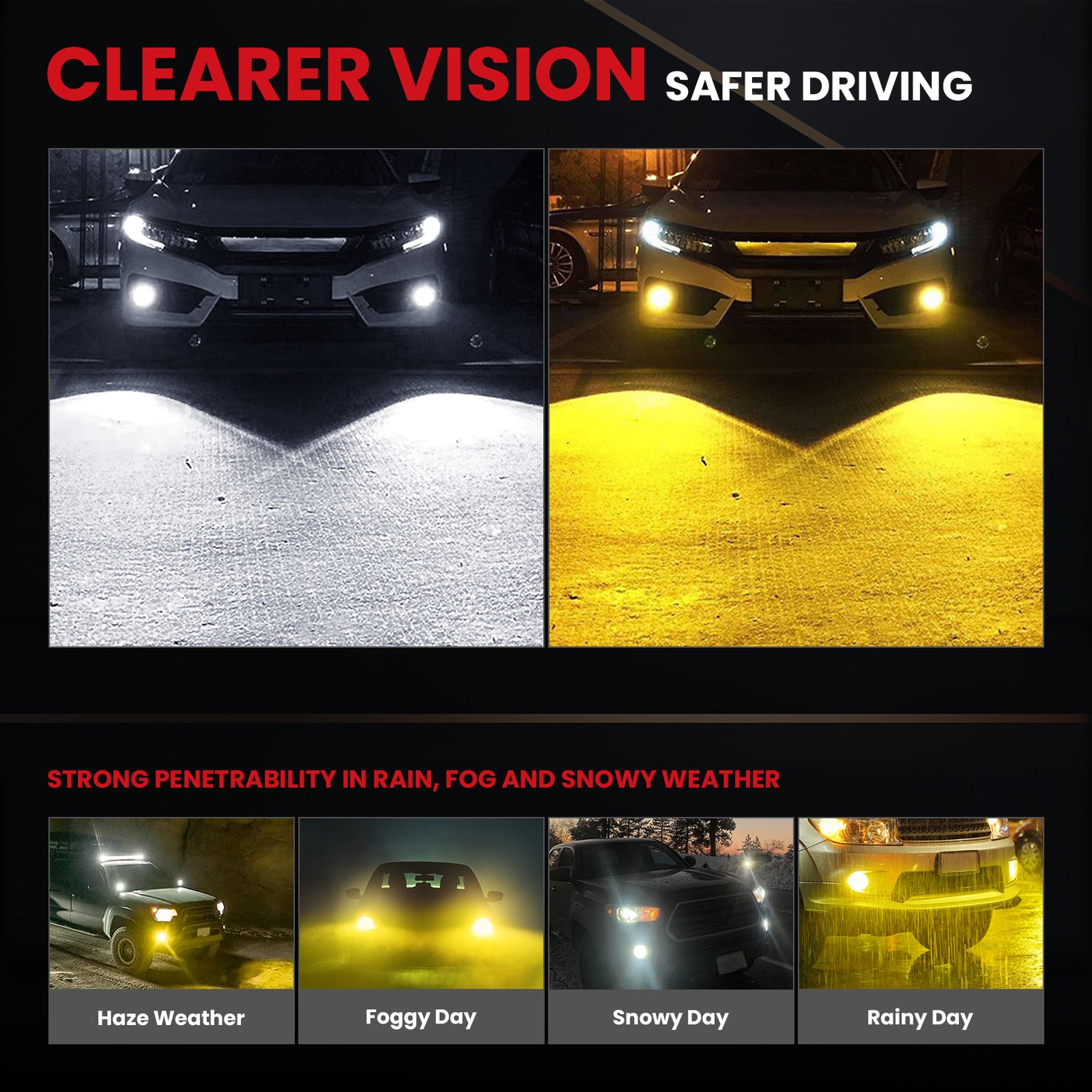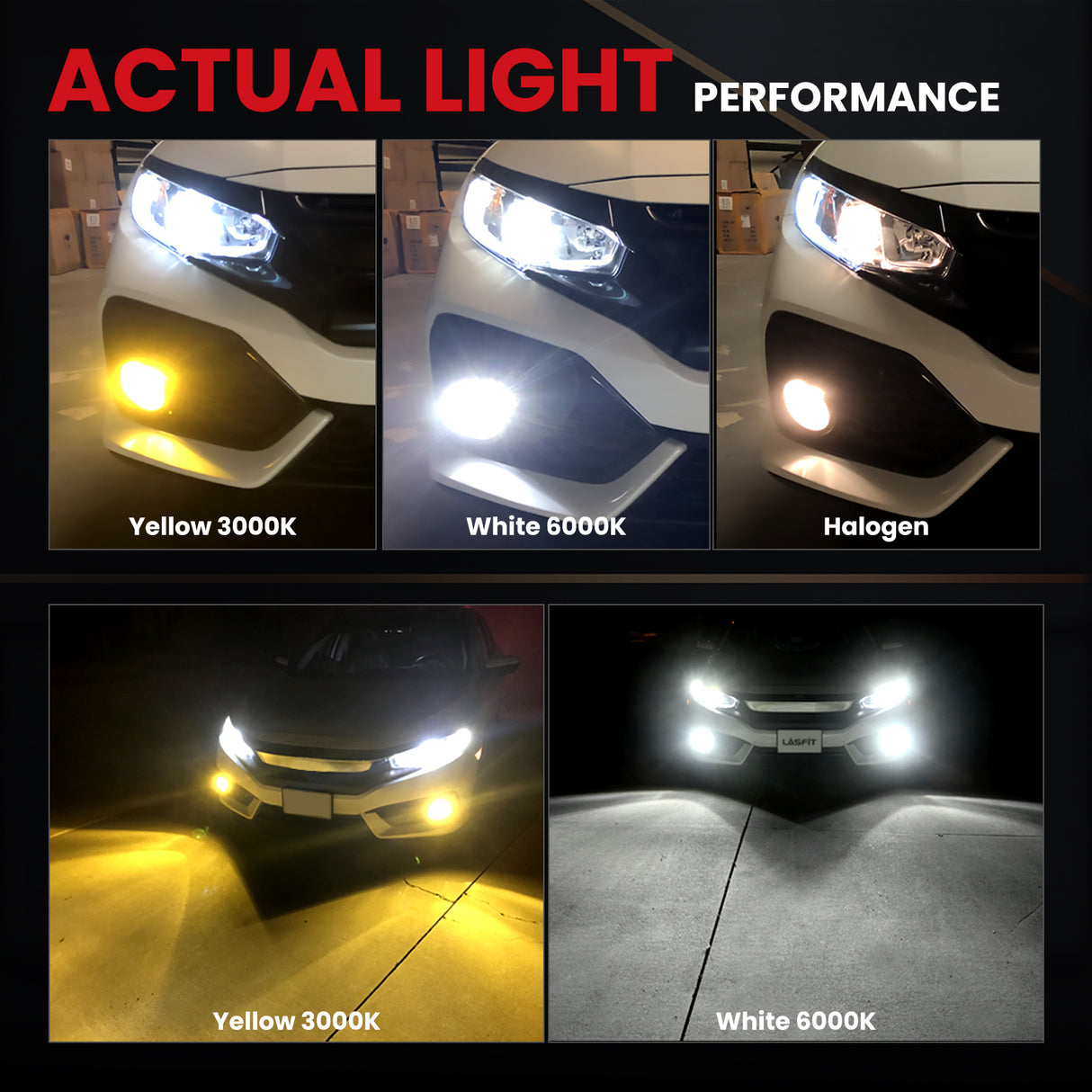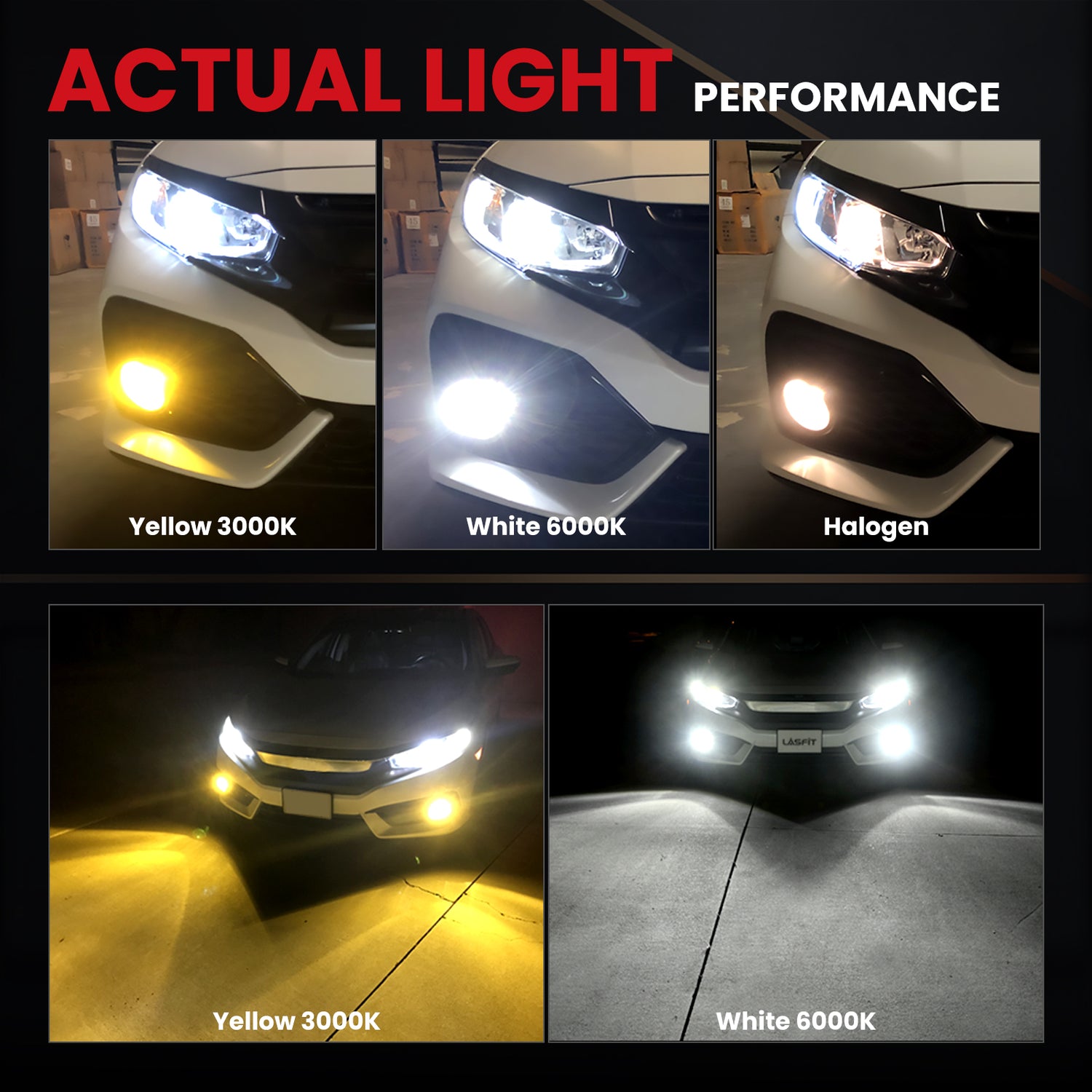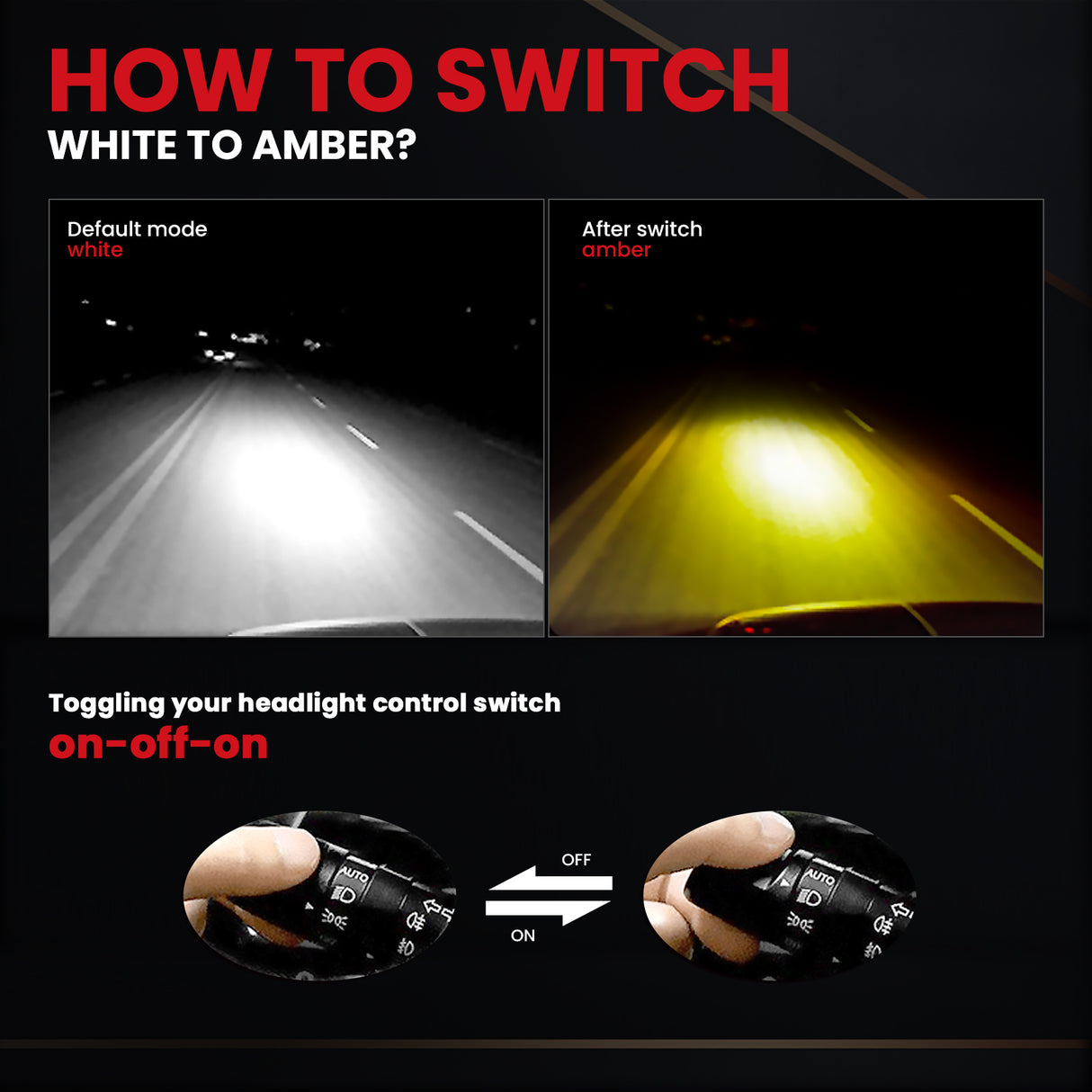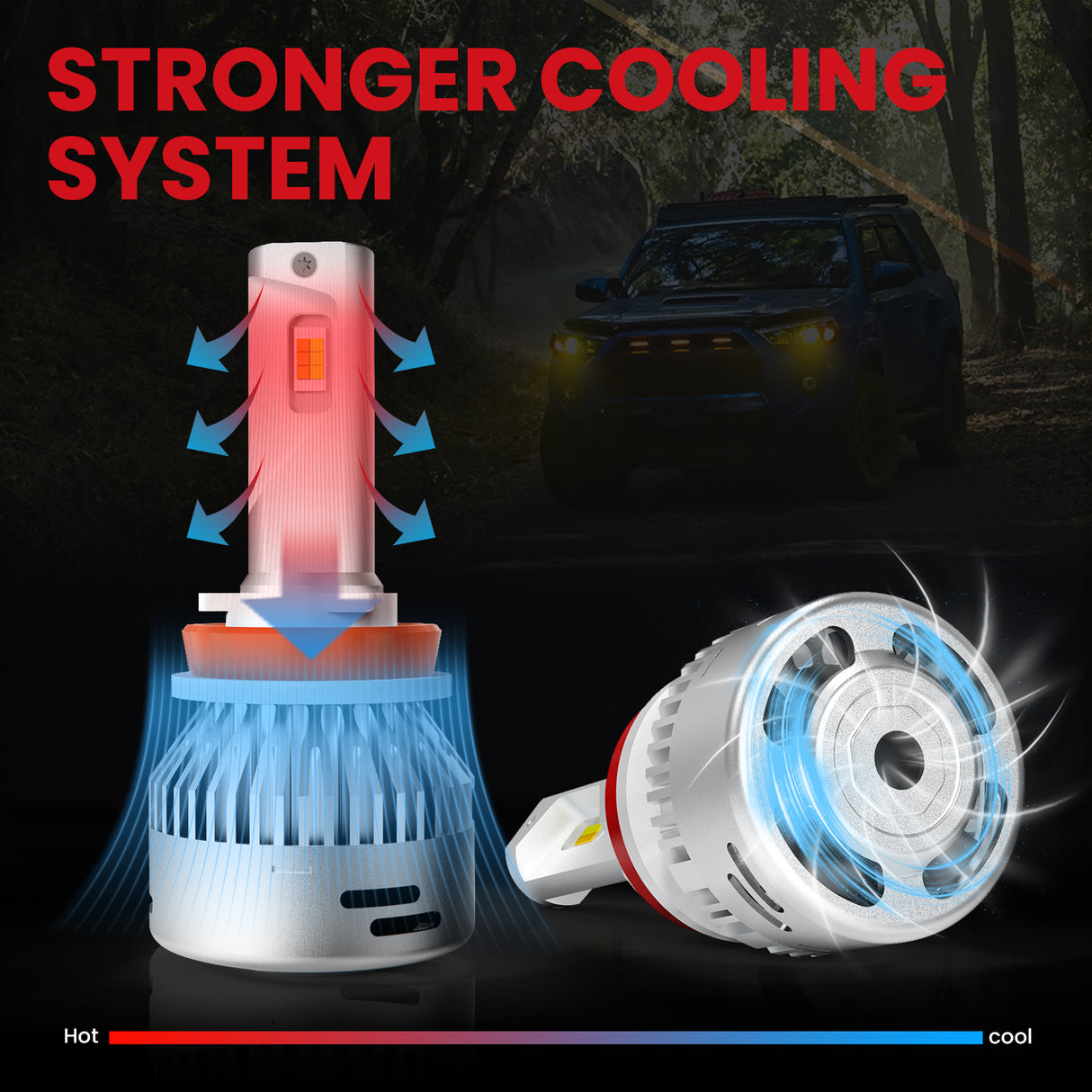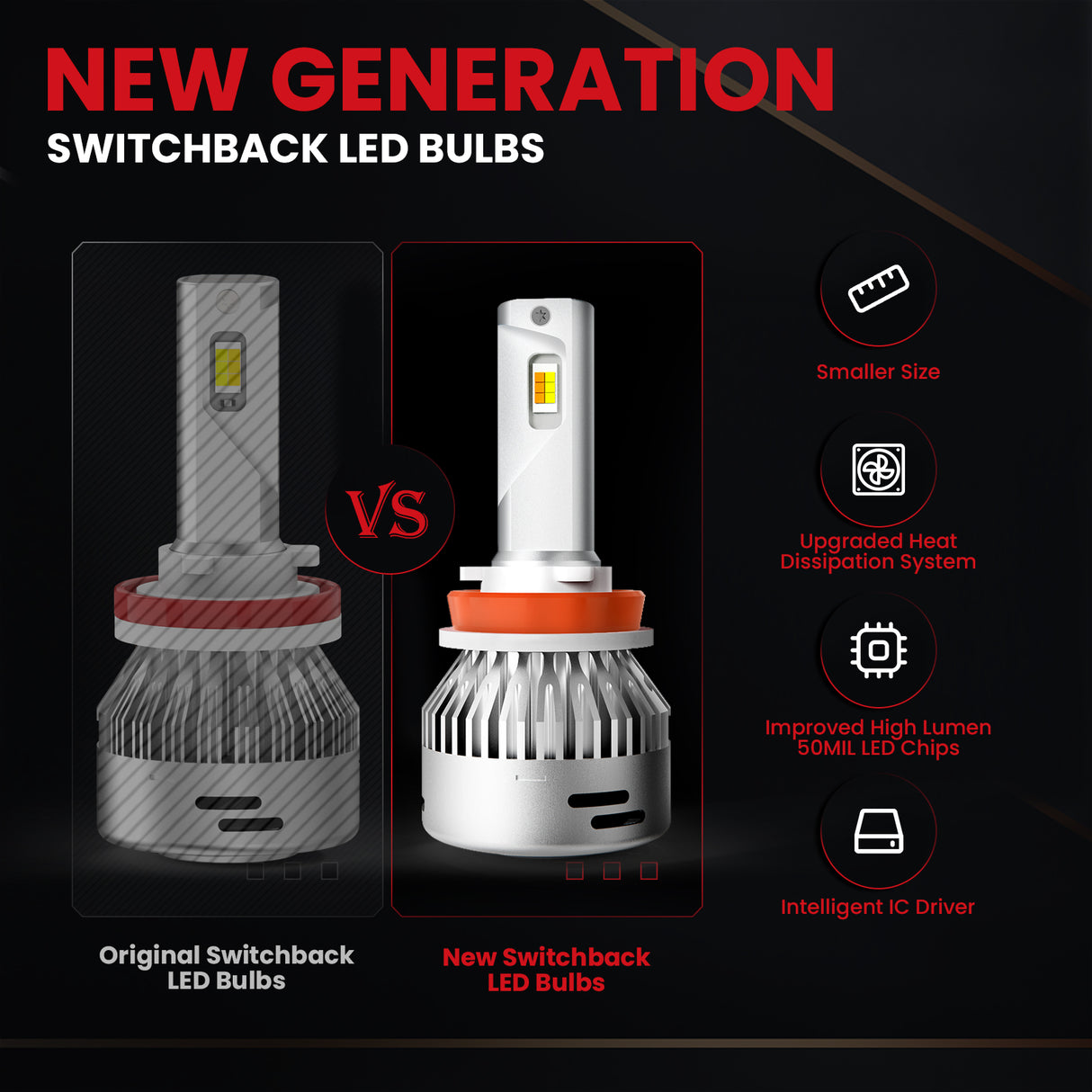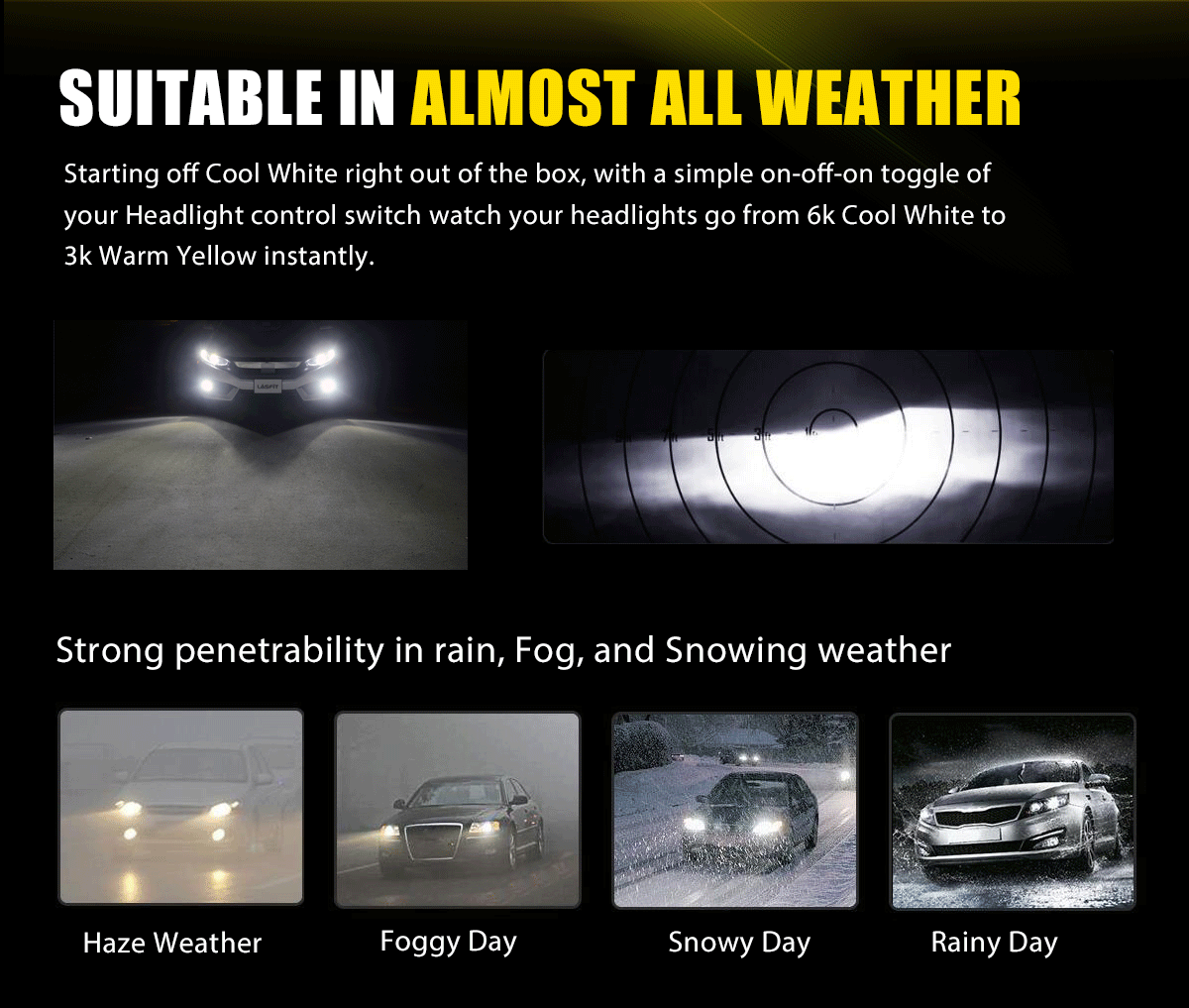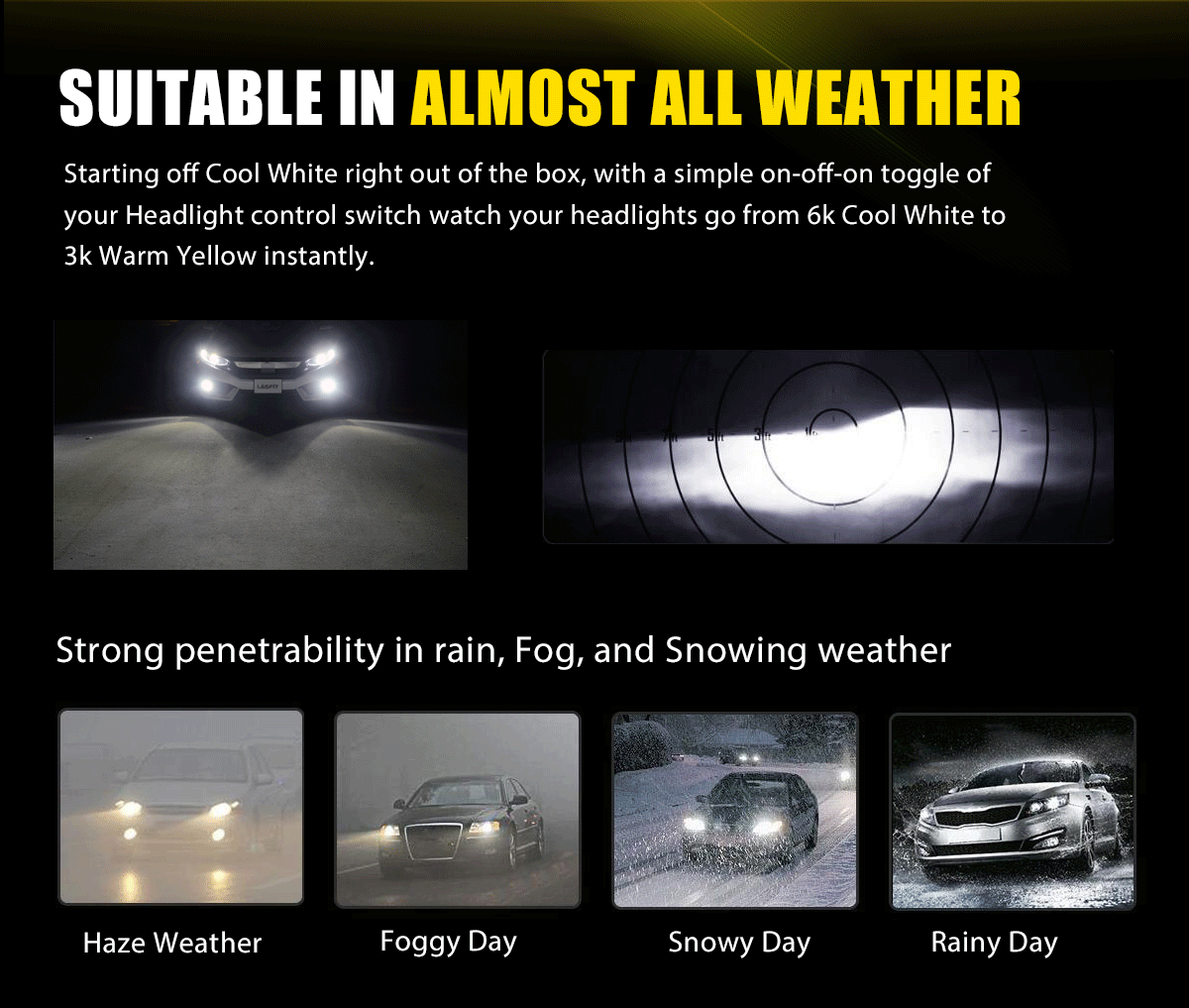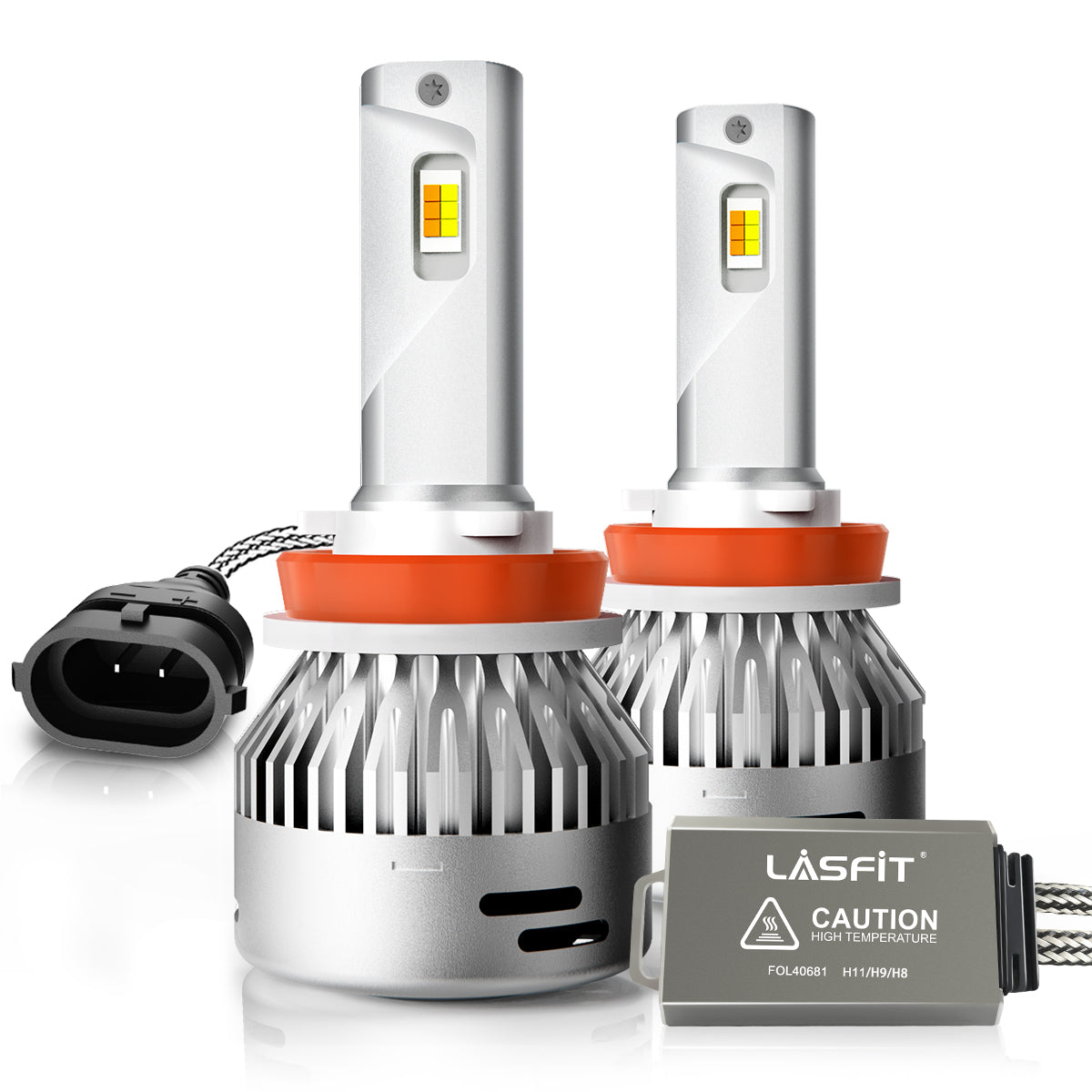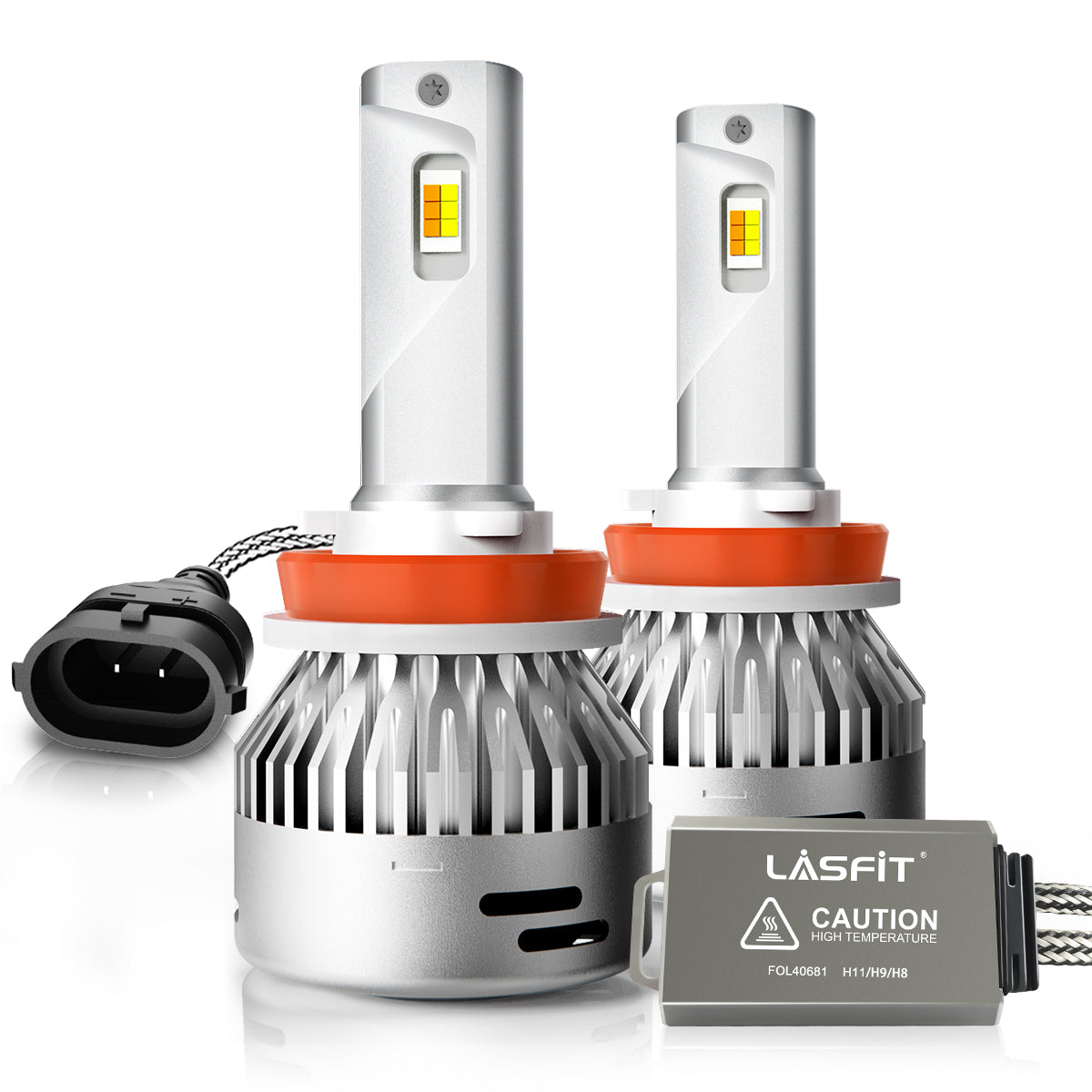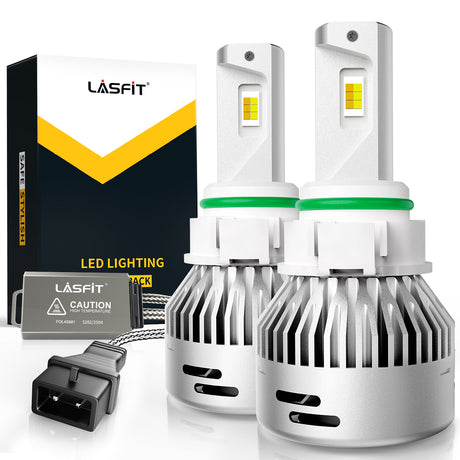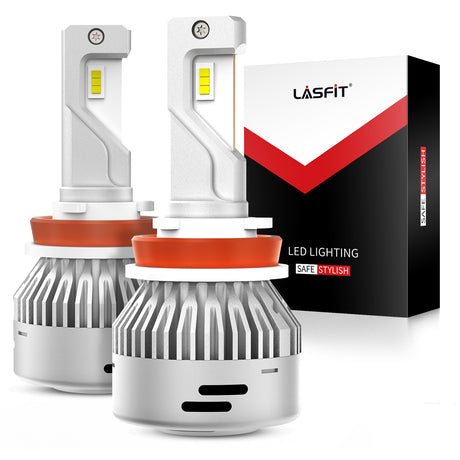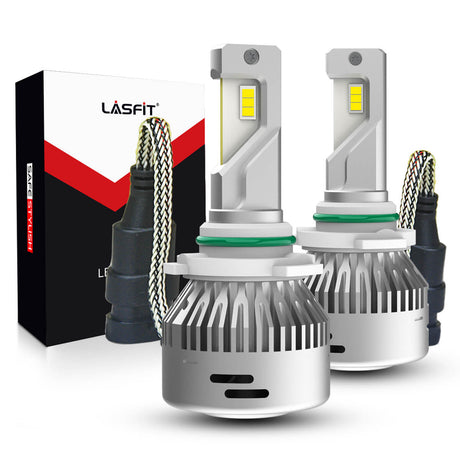In some cases, you might need yellow fog driving lights or white fog automotive lights in your vehicle, for example:
"I was driving at night and noticed that my fog lights weren't doing me any justice especially on snow / raining days."
"I noticed I was not getting a sufficient amount of light with the stock halogen bulbs and felt it would be nice to have the yellow bulbs to light up the road much more."
But when upgrading your fog lights, one question comes up often:
Should you choose yellow or white fog lights?
This guide breaks down the differences, pros and cons, and helps you choose the right fog lights for your driving needs — including expert recommendations and FAQs.
Table of contents
- What Are Yellow Fog Lights And White Fog Lights?
- Yellow vs. White Fog Lights: Side-by-Side Comparison
- Key Advantages of Yellow LED Fog Lights in Adverse Weather
- How To Choose The Best LED Fog Lights?
- Top Yellow Fog Driving Lights Recommendations From Lasfit
- FAQs About LED Fog Light Bulbs
What Are Yellow Fog Lights And White Fog Lights?
The halogen fog light bulbs are tend to be 3200K which enclose to sunset. The LED fog light are colese to halogen but it tends to be 3000K with brighter light footage to prevent accidents.

White fog lights typically fall within the 5000K to 6500K color temperature range, producing a crisp, cool white beam that closely resembles daylight. They are commonly found in modern LED and HID fog light systems and are popular for their sleek appearance and compatibility with white LED headlights.
White fog lights offer excellent brightness and road illumination, especially on clear nights or in urban environments. Their high output helps drivers see more detail on dark roads, including road signs, lane markers, and obstacles around curves.
However, in dense fog, snow, or heavy rain, white light tends to scatter more easily due to its shorter wavelength. This can create glare or reflect off moisture particles, potentially reducing visibility. Despite this, white fog lights remain a favored choice for drivers who prioritize style, brightness, and better integration with modern headlight systems.
Yellow fog lights typically emit light at a color temperature around 3000K, giving off a warm, golden hue similar to sunlight at dawn or dusk. This specific wavelength penetrates fog, rain, and snow more effectively than white light, thanks to its reduced scatter and lower glare potential.
The primary advantage of yellow fog lights lies in visibility during adverse weather. The longer wavelength of yellow light helps it cut through particles in the air—such as water droplets, snowflakes, or dust—without reflecting back at the driver. This improves contrast and reduces eye strain, allowing drivers to spot road edges, obstacles, or oncoming vehicles with greater clarity.

Yellow vs. White Fog Lights: Side-by-Side Comparison
Now that we’ve covered the basics of two color fog lamps, it’s time to answer one of the most common questions among drivers:
Which is better—yellow fog lights or white fog lights?
| Feature | Yellow Fog Lights | White Fog Lights |
|---|---|---|
| Color Temperature | 3000K-3200K (warm, sunset-like) | 5000K-6500K (cool, daylight-like) |
| Wavelength | 570-590nm | 400-700nm |
| Fog Performance | Excellent: Reduces backscatter by 40% | Poor: Creates "white wall" glare |
| Best For | Heavy fog、Snowstorms、Rain | Clear nights、Urban driving、Dry conditions |
| Rain/Snow Visibility | High penetration: Cuts through precipitation | Lower penetration: Reflected more by water droplets |
| Glare for Oncoming Drivers | Minimal: Easier on others’ eyes | Moderate: Can cause glare in dense fog/snow |
Yellow Fog Lights
Color Temperature: 3000K-3200K (warm, sunset-like)
Wavelength: 570-590nm
Fog Performance: Excellent:Reduces backscatter by 40%
Best For: Heavy fog、Snowstorms、Rain
Rain/Snow Visibility: High penetration: Cuts through precipitation
Glare for Oncoming Drivers: Minimal:Easier on others’ eyes
White Fog Lights
Color Temperature: 5000K-6500K (cool, daylight-like)
Wavelength: 400-700nm
Fog Performance: Poor:Creates "white wall" glare
Best For: Clear nights、Urban driving、Dry conditions
Rain/Snow Visibility: Lower penetration: Reflected more by water droplets
Glare for Oncoming Drivers: Moderate:Can cause glare in dense fog/snow
Here's a refined version of the pros and cons, maintaining your core information while enhancing clarity and technical accuracy:
Yellow Fog Lights
Pros:
- Excellent in extreme weather: Yellow fog lights offer better visibility in fog, snow, and heavy rain due to longer wavelengths.
- Reduced glare: The soft amber tone is less likely to reflect off water droplets or snow, minimizing glare for both you and oncoming traffic.
- Better eye comfort: Yellow light causes less eye strain in low-visibility conditions and enhances contrast on wet roads.
- Ideal for bad weather driving: Perfect for drivers in regions prone to frequent storms or snowfall.
Cons:
- Lower brightness on clear roads: May appear dimmer compared to white lights in dry or urban environments.
- Limited visual appeal: The yellow hue may not match modern vehicle aesthetics or factory LED headlights.
- Not a one-size-fits-all solution: Some drivers find them less suitable for everyday or clear-weather driving.
White Fog Lights
Pros:
- High clarity in normal conditions: White fog lights provide excellent road illumination in dry weather and low-light areas.
- Modern appearance: Offers a clean, crisp look that matches OEM LED headlight systems.
- Brighter perception: Even at the same lumen rating, white light appears brighter to the human eye, improving visibility on dry roads.
Cons:
- Less effective in poor weather: White light reflects more off fog and snow particles, creating glare and reducing visibility.
- Causes more glare: The shorter wavelength increases refraction and can dazzle other drivers, especially in fog.
- Can cause eye fatigue: Prolonged exposure to intense white light during night or storm driving may strain your eyes.
Key Advantages of Yellow LED Fog Lights in Adverse Weather
When the weather takes a turn—fog rolls in, rain starts pouring, or snow begins to fall—standard headlights and even white fog lights often fall short. This is where yellow fog lights shine—literally and figuratively. Thanks to their lower color temperature and longer wavelengths, yellow fog lights offer distinct advantages that make them the top choice for driving in low-visibility environments.
Superior Penetration & Reduced Scatter: The defining feature of yellow fog lights (around 3000K) is their longer wavelength (~585nm). This allows the light to cut through dense fog, heavy rain, snow, and dust particles far more effectively than shorter-wavelength white light. Crucially, it minimizes backscatter – the phenomenon where light reflects off airborne particles back towards the driver, creating a blinding "white wall" effect. Yellow light reduces this backscatter by up to 40%, drastically improving forward visibility.

- Significantly Reduced Glare: The warm, amber hue is inherently less glaring, both for the driver using them and for oncoming traffic. White light's shorter wavelength refracts (bends) more intensely within water droplets or snowflakes, causing intense, distracting glare. Yellow light's longer wavelength refracts less, resulting in a softer, less blinding beam that illuminates the road surface without reflecting harshly back at you or others.

- Enhanced Contrast & Object Recognition: Yellow light improves the contrast between objects (like road edges, obstacles, or animals) and the background in low-visibility conditions. The reduced scatter and glare mean more light reaches the road surface where it's needed, making dark objects stand out better against wet asphalt or snow, and making lane markings more visible.

- How Does Customer Saying:
"One of them being the ease of the install and no extra wiring or ballasts needed. Also for the longevity of the bulbs. I was replacing the halogen bulbs constantly it feels like. They also were dull and didn’t provide the light output I wanted. The LEDs have a quick response when turned on and don’t need a few seconds to warm up like HIDs."

*From Josh Maldonado who completely unsatisfied with the stock light output from the headlights and fogs.

"Lack of light on the road, Having an all black car and the yellow lights really pop and looks perfect with it. I can now see much further ahead and won’t have to worry about wild life or obstructions on the road again!"
*From Tristan Johns who decided to upgrade her fog lights because he noticed he was not getting a sufficient amount of light with the stock halogen bulbs
In summary: When visibility plummets due to fog, heavy snow, or relentless rain, yellow fog lights are scientifically proven to outperform white lights. Their longer wavelength penetrates airborne particles better, minimizes dangerous backscatter and glare, provides superior contrast, reduces driver eye strain, and offers a clear visual signal to others. For drivers frequently encountering severe weather, yellow fog lights are not just an upgrade – they are a critical safety enhancement designed to illuminate the path ahead when you need it most.
How To Choose The Best LED Fog Lights?
Before upgrading your vehicle’s lighting system, it's essential to evaluate these critical factors to ensure optimal fog light performance, road safety, and visibility in all weather conditions:
- Brightness (Lumens Output): For effective visibility in foggy or rainy conditions, choose LED fog lights with at least 3,000 lumens per bulb (or 6,000 lumens per pair). This ensures strong road illumination without overwhelming glare.
- Precision Beam Pattern: A sharp, focused cut-off line is vital to avoid blinding oncoming drivers. Look for fog lights engineered for optimal beam control and safe, road-legal output.
- Color Temperature & Switchback Modes: Decide between 6000K white fog lights for maximum clarity in normal weather and 3000K yellow fog lights for better penetration through fog, snow, and rain. For ultimate versatility, consider dual-color or switchback fog lights that allow easy switching between modes.
- Thermal Management & Build Quality: High-quality LED fog lights feature aircraft-grade aluminum housings, integrated cooling fans, or copper heat pipes to dissipate heat efficiently and prolong lifespan.
- Easy Plug-and-Play Installation: Choose fog lights that are 100% plug-and-play, requiring no complex wiring, modifications, or error codes. This simplifies installation and saves time.
- Warranty & Brand Reliability: A longer warranty (typically 1–2 years or more) combined with responsive customer support is a good indicator of a reliable fog light manufacturer you can trust.
Top Yellow Fog Driving Lights Recommendations From Lasfit
Lasfit LD Plus Series LED Fog Lights
The Lasfit LED LD Plus Series Fog Lights stand out as a top choice for those seeking superior performance, durability, and functionality in a switchback LED fog light. Featuring a dual-color switchback design, these fog lights allow you to seamlessly switch between 6000K white and 3000K yellow light, providing excellent visibility in various driving conditions. Whether you're facing fog, rain, or snow, the Lasfit LD Plus series delivers the clarity and safety you need.
Key Features:
- Brightness: 6000 lumens per set (3000 lumens per bulb), offering 400% brighter output compared to standard halogen bulbs.
- Modes: 6000K cool white light for clear visibility at night, and 3000K warm yellow light for optimal performance in harsh weather conditions, such as fog or snow.
- Beam Alignment: Equipped with a 360° adjustable socket, allowing precise beam pattern control to avoid glare and ensure safe driving.
- Cooling System: Features a compact aluminum body with a dual ball-bearing fan, designed to provide superior heat dissipation for longer-lasting performance.
- Easy Installation: The LD Plus Series is designed for quick plug-and-play installation, eliminating the need for complicated wiring or modifications.
- Warranty: Backed by a 1-year warranty with responsive customer support to address any concerns.
FAQs About H7 LED Bulbs
1. Q: What makes fog lights different from regular headlights?
A: Fog lights car are mounted lower and project a wider, shorter beam close to the road. This design reduces light reflection in fog, rain, or snow, offering better visibility than regular headlights in low-visibility conditions.
2. Q: When should I use fog lights?
A: Use fog lights during low-visibility conditions such as dense fog, heavy rain, or snow. Avoid using them in clear weather to prevent distracting other drivers.
3. Q: Can LED fog lights improve nighttime driving?
A: While primarily designed for adverse weather, LED fog lights can also enhance peripheral illumination during night driving in rural or unlit areas—though they are not a substitute for headlights.
4. Q: Are LED fog lights better than halogen?
A: Yes. LED fog lights generally offer improved brightness, lower energy usage, and longer lifespan compared to halogen. They also produce a more focused, whiter light that enhances clarity.
5. Q: Can I upgrade my halogen fog lights to LED?
A: In most cases, yes. Lasfit offers LED fog light bulbs that fit standard halogen housings. Some vehicles may require additional components like resistors or decoders to ensure compatibility.
6. Q: What should I do if my fog lights keep burning out?
A: Frequent failures can result from poor bulb quality, improper installation, or electrical issues. Choose high-quality, vehicle-specific LED fog bulbs and inspect wiring connections for stability.
7. Q: Can fog lights be used as DRLs (Daytime Running Lights)?
A: In some vehicles, fog lights can be used as daytime running lights, but this depends on the make and model of the car. Some modern vehicles have DRLs built into the fog light system, providing added safety by making the vehicle more visible during the day. However, fog lights used as DRLs may not be as bright as purpose-built DRLs.
8. Q: How do I aim or align my fog lights properly?
A: Fog light lamps should be adjusted to illuminate the road just ahead of the vehicle without shining into the eyes of oncoming drivers. For best results, use a level surface and refer to your owner’s manual or consult a professional technician.
9. Q: Are Yellow or White Fog Light Illgal?
A: It depends on your location or where you are going to visit. In general, yellow, amber, and white are both legal across the United States. But the dangerous fog light, built with red, blue, or other colors can be hazardous. It is illegal in many states.


